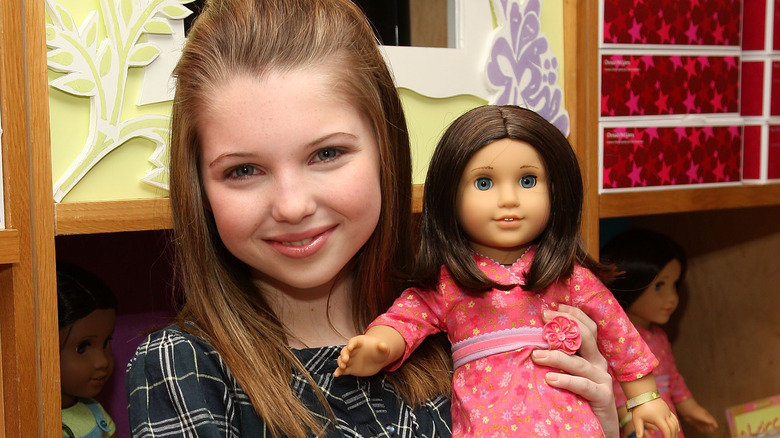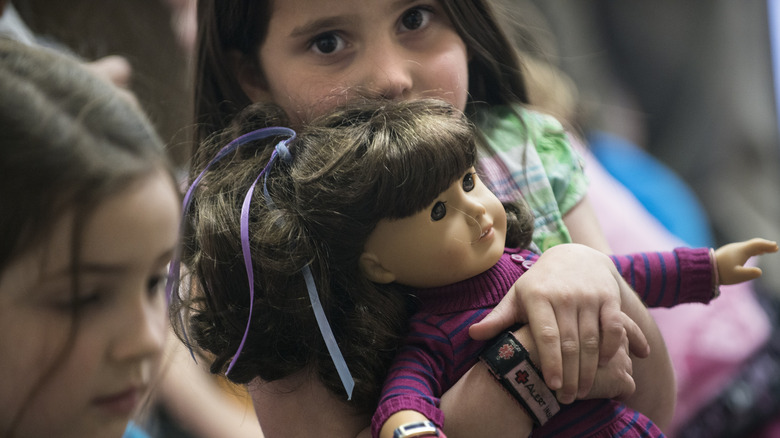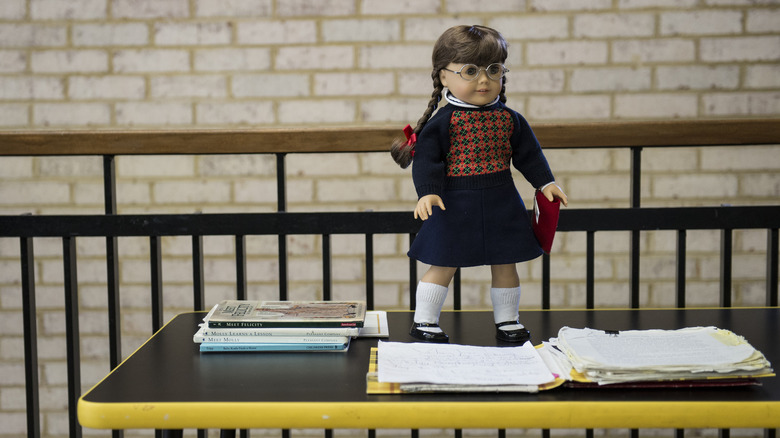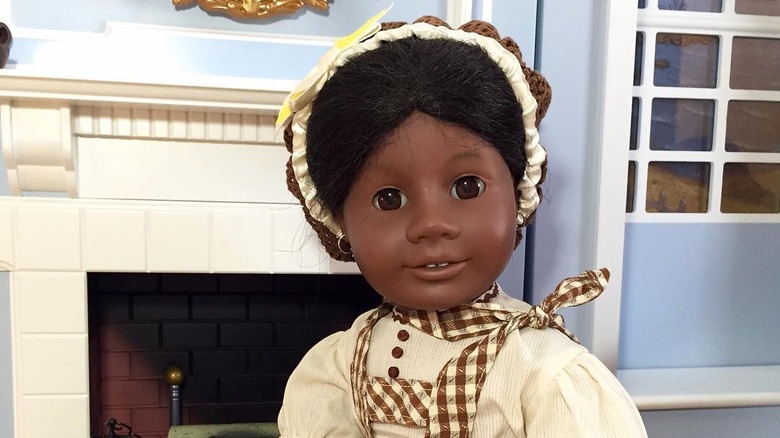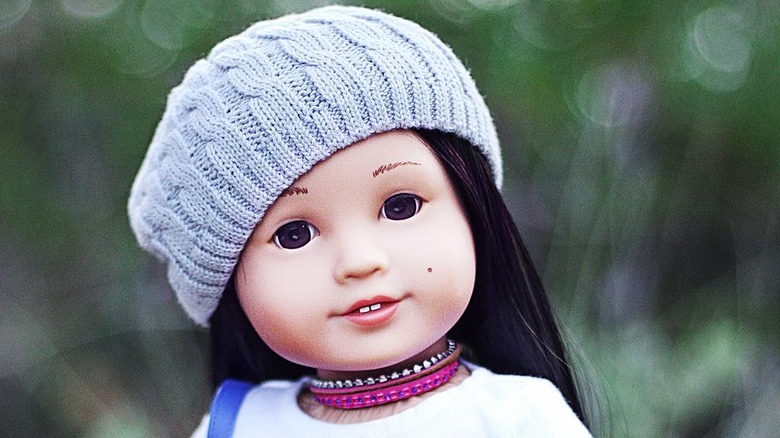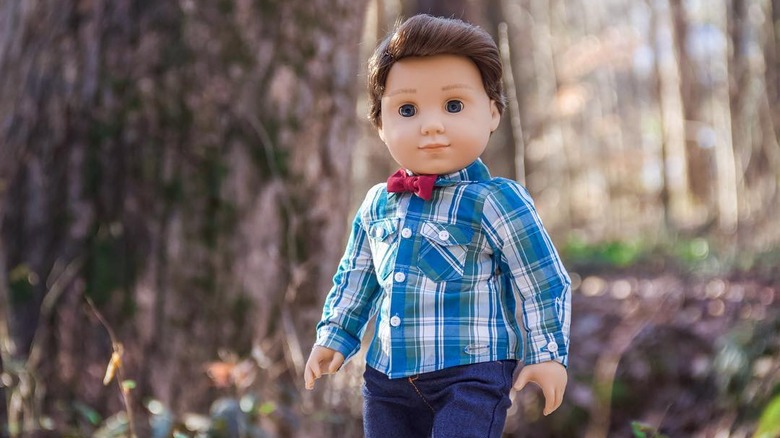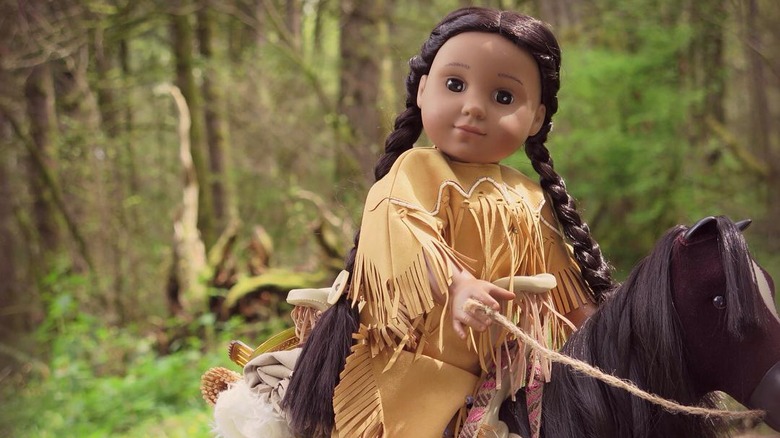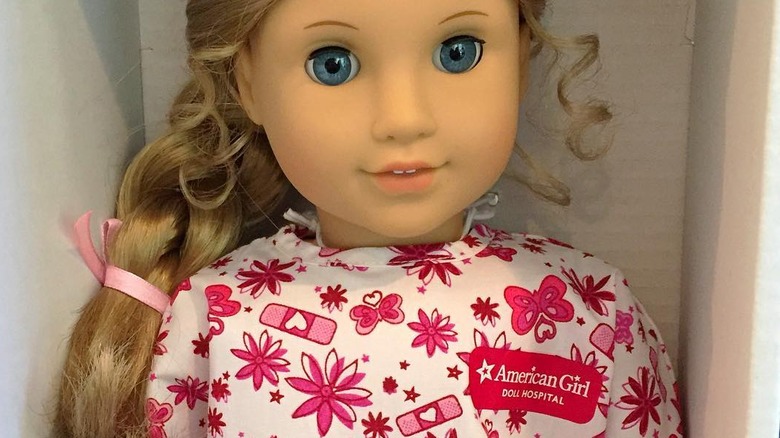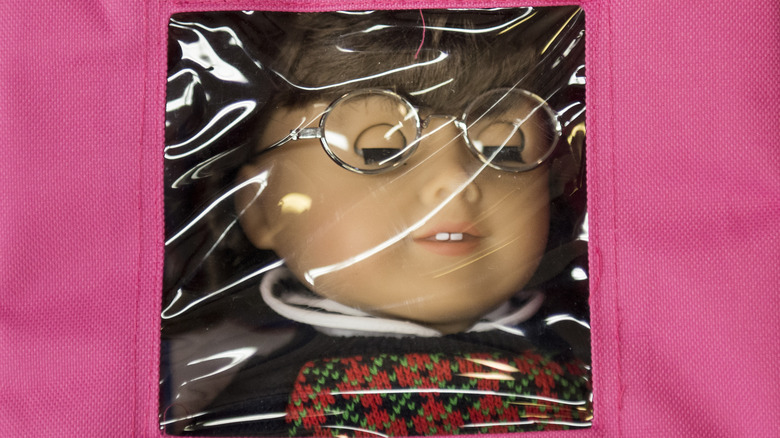Things About American Girl Dolls You Only Notice As An Adult
How would you respond if someone were to ask you, "What's an American Girl doll?" It would be hard to summarize such a large part of your childhood in just a few words but you could probably say something like, "Only the most magnificent toy in the history of ever." At least, that's how you might remember it. While it seems like just a blip in history, the iconic brand has already been around for more than 25 years. Feeling old yet?
Here are some other things you may not have realized about American Girl dolls back when you were a kid.
These dolls were not cheap
American Girl dolls were never cheap. Sure, they were quality-made and, as already discussed, magnificent! But, there were certainly always cheaper — much, much cheaper — alternatives on the market.
According to americangirl.com, you can purchase a new doll with the accompanying book for $115. In an unusual turn of events, the cost of these dolls has actually gone down since you became an adult. That's right, even counting inflation, American Girl dolls in 2018 are less expensive than they were in the late '80s and early '90s, as reported by The Billfold.
Are the dolls worth it? Mandi Ehman, a mother of four, told AOL, "I still have my doll, and she still looks beautiful. To me, it's definitely worth the investment in the dolls themselves."
However, even if you were (somehow) satisfied with just having one American Girl doll, there's no way you had only one outfit for her. With outfits also came accessories. You had to have one of those horses too, right? AOL broke down the average cost associated with owning just one of these dolls: $644. Oh, man. Maybe don't tell people just how bad your addiction was to these dolls.
Still, parents are buying them. "There are very positive messages. It is a nice simple, straight forward, and a very non-sexualized version of girl power," Erica J. Sandberg, another parent, told AOL. "The only regret is that kids can get so wrapped up with everything."
Before the internet, there were American Girl dolls
In 1986, American Girl dolls began being sold, which means that — believe it or not — they predate the internet. The World Wide Web as we know it came into existence in 1991 and it really wasn't until early1995 that online shopping got its start. Yet, according to Forbes, Pleasant Rowland, the owner and inventor of American Girl dolls, had made $300 million in sales and went on to sell her company to Mattel for around $700 million in 1998 — all without the internet.
You've been able to purchase essentially everything online for years now so it may be hard to remember how you ever bought things in the good ole days. Specialty items, including your cherished American Girl dolls, had to be mail-ordered.
Can you remember rummaging through your American Girl doll catalog as soon as it arrived? You'd circle your favorite dolls and coordinating accessories and try your best to convince your parents that you needed everything. After eventually wearing them down, you'd then wait for weeks — yes, weeks — but it was all worth it when your doll arrived on your doorstep.
Granted, this process wasn't actually magic, but when your parents were the ones responsible for paying, it sure felt like it. Nowadays, American Girl dolls can be bought online or purchased at one of 20 retail stores.
Dishing out some major life lessons
Before so-called "educational toys" became a trend, '90s kids were already figuring out how to weaponize the term to get their parents and grandparents to buy them toys for learning. Because the books that accompanied the American Girl dolls told their pseudo-backstories, you could reason with your mom, "But this doll is from the Victorian era and this one is a patriot from World War II." Their scholarliness may have been a bargaining chip, but those who played with the dolls and read the books were truly learning.
Tricia Radford, a 30-year-old nonprofit consultant in New York told The Atlantic that she can remember learning all about "what it was like to be poor in the early 20th century." The Atlantic further explained that the Samantha doll taught girls about class privilege and the power of speaking up for what you believe in. Quite the feminist!
While many dolls at the time were solely made to look like the children who would be playing with them, American Girl dolls accomplished more than that. They opened the minds and imaginations of so many young girls and enabled them to picture what it would be like to walk in someone else's shoes.
More than just stories
The great Ernest Hemingway once stated, "There is no friend as loyal as a book." Perhaps the addendum to that would be, "and an American Girl doll." Okay, maybe that's a bit much, but the books that accompanied the dolls were quite good. No, they weren't New York Times Bestsellers but they served a noble purpose.
Freelance author Valerie Tripp, who has been writing for American Girl for over 30 years, described some of the process to Patch. "After I come up with the character, I do enormous research which includes reading, travel, talking, cooking lessons, fashion, movies, everything regarding the time period," she explained.
She further explained that her entire goal is to "distill major social problems" during the chosen time period. According to Tripp, the dolls are an allegory or metaphor for what was going on at the time. Tailoring those subjects to young readers is a challenging task that sometimes takes as long as three years.
In addition to writing many books, Tripp also takes the time to reply to every single letter she receives, even though she gets thousands of them. "I love the letters. If a girl writes me a letter, then she has begun communication, so the least I can do is write back."
They weren't without their controversy
While American Girl dolls were educational, they weren't exempt from controversy. Although the company launched in 1986, it wasn't until 1993 that a black doll, Addy Walker, was introduced. According to Slate, Addy was the only doll representative of young black girls for nearly two decades.
While diversifying was certainly the right thing to do, the backstory of Addy, as a 9-year old girl born into slavery journeying to and eventually achieving freedom, left many disappointed. Still, the making of the doll persisted. Angered consumers formed a petition to retire the doll some 20 years after her release citing, "Slavery was a vile, cruel, inhumane, unjust holocaust of Black Americans. Generations of lives were lost in the slave trade. Why would this subject matter ever be considered entertaining?"
However, not everyone agreed. "Some people don't want to see a character in slavery — that's ridiculous," novelist Connie Porter, who was hired to write Addy's story, told The Washington Post, "You can run the risk of being so politically correct that you can lose whole periods of history." Porter added, "Children are more ready to talk about these things than some adults are."
Agree or disagree, Addy Walker has not yet been retired.
What about other races and cultures?
Referring to American Girl dolls of the '90s, Slate labeled the brand "overwhelmingly white." It could be argued, though, that the brand continued this way for even longer.
According to NBC News, American Girl's first release of an Asian-American doll (Ivy Ling) occurred in 2007. That means most of us didn't have the option for an Asian-American doll throughout our childhood. Still, parents and children were no doubt happy to see the brand become more inclusive — even if it wasn't until 2007. Sadly, this excitement was relatively short-lived. In 2014, American Girl made another controversial decision, which was to discontinue the Ivy Ling doll.
"It doesn't make sense to me as a parent," Nina Ha, a mother of two, told NBC News. "I don't see the benefit of taking away their only Asian-American doll. It seems like it's limiting our children's choices and diminishing the Asian-American voice."
Thankfully, American Girl seemed to see the error of their ways and debuted a Korean-American doll, Z Yang, in 2017. Perhaps better late than never.
Did they forget about the boys?
Are dolls just for girls? In the '90s, the popular answer from parents may have been "yes," but times have changed.
"Boy toys are often developed and marketed to promote aggression and competition while girl toys promote nurturing and relationship building," Jennifer Shewmaker, associate professor of psychology at Abilene Christian University, explained to The Boston Globe. "Healthy people know how to balance all of these traits. Giving boys the chance to explore nurturing and connecting with others opens up opportunities for them to build important life skills."
In 2017, American Girl did make a stride toward inclusivity by introducing male doll Logan Everett. Stephanie Spanos, American Girl spokeswoman, told USA Today, "A boy character has been a top request from our fans for decades.”
It is disappointing that it took until 2017 for American Girl to comply with fans but at least they are trying. Spanos continued, "We're hopeful Logan will appeal to both girls and boys...For boys, we know Logan can speak directly to them and give them something unique and special to call their own.”
American Girl keeps it real
While it may be easy to rag on American Girl for their faults — hindsight is 20/20 after all — the dolls were still remarkable in many ways, even back in 1986 when they were released.
According to americangirl.com, each doll takes well over a year, from design concept to production. Doll-making is truly an art and American Girl is no exception. The site explains that each face shape is sculpted by hand! Additionally, American Girl wants their dolls to look realistic. So realistic, in fact, that they create the dolls' faces to be asymmetrical just like a person's.
American Girl also curls the eyelashes of the dolls — by hand. Both skin texture and color are carefully chosen and meant to appear as lifelike, "even down to the eyelid color and sprinkle of freckles." There's no doubting the impressive craftsmanship of these dolls.
Say cheese!
One of the most interesting things about American Girl dolls are their smiles. Unlike many dolls, you actually get to see their toothy grins. Every American Girl doll you owned had an adorable little bucktooth smile and American Girl continues to produce dolls with teeth, aside from one.
According to Racked, the Kaya doll is a nine-year-old Native American girl living in the Northwest and the only one without the traditional smile. American Girl was so determined to have this doll appear as authentic as possible that they worked with the Nez Perce tribe. In doing so, they learned that showing teeth is considered an act of aggression in their culture. Therefore, Kaya would have never shown her teeth in that manner.
Instead of scrapping the doll because it didn't fit their mold or bucking authenticity, it's great to see American Girl represent this Native American tribe accurately.
The facade of the Doll Hospital
If anything tragic ever happened to your American Girl doll, you could sleep easy knowing you could just ship her off to the Doll Hospital.
When you were young, you probably pictured the Doll Hospital to be, well, a hospital for dolls. Instead, it is more like a warehouse. Thanks to an exclusive all-access tour for Oprah, you can take a peek. Still, the "hospital" will treat all kinds of injuries including damage from markers and even the resulting effects of putting the doll in the dryer. Yikes!
The method of returning the doll is much the same as it was in the '90s. Your doll will come back with a certificate of good health and an adorable hospital gown and bracelet. Generations of young children will go on believing the hospital is real and, why not?
So, what are they worth?
If you dare to sell your old American Girl dolls, you could stand to make some money. According to BuzzFeed, the most valuable dolls are the ones that have been retired or "achieved." Molly, Felicity, Kirsten, and Samantha would probably get you the most bang for your buck.
While BuzzFeed reported some eBay listings went as high as $2,199.99, most of the retired dolls appear to sell for anywhere around $50 to $260. Depending on condition, you could likely recoup what you your parents paid.
But, seller beware: You should probably keep some Kleenex nearby while you box them up.

